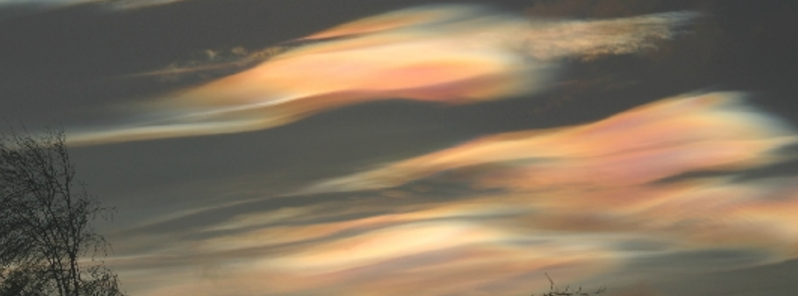Ozone hole behind colorful nacreous clouds over the UK and Ireland

Polar stratospheric clouds (PSCs) are appearing over the United Kingdom and Ireland since January 31, 2016. An extremely rare occurrence for this area, usually restricted to the Arctic Circle, has been photographed by numerous skywatchers. According to experts, the phenomenon is caused by a temporary ozone hole over the UK and Ireland.
The PSCs, also known as nacreous clouds, appeared almost every day over the last week, according to eyewitness reports. This colorful weather phenomenon happens in the lower stratosphere when temperatures drop to -85 °C (-121 °F). When high-altitude sunlight reaches the small particles of ice approximately 10 µm (393.7 µinches) wide, diffraction and interference produce bright iridescent colors.

Saltburn by the Sea, UK, February 2, 2016. Image credit: David Stock via Severe Weather Europe

Nacreous clouds over Kildare, Ireland, February 2, 2016. Image credit: Gingham Sky Photo via Meteo Europe
Some PSCs contain tiny droplets of nitric and sulphuric acids that can destroy ozone. According to Les Cowley, the atmospheric optics expert, a temporary ozone hole has been reported over UK and Ireland.

Nacreous clouds over Edinburgh, Scotland, February 2, 2016. Image credit: Colin Fraser

Nacreous clouds over Edinburgh, Scotland, February 2, 2016. Image credit: Colin Fraser
"The acid droplets destroy the stratospheric ozone layer that protects us from harmful solar ultraviolet rays. They catalyse unreactive forms of man-made chlorine into active free radicals (for example ClO, chlorine monoxide). The radicals destroy many ozone molecules in a series of chain reactions," explained Cowley.

The blue patch over UK and Ireland reveals a temporary ozone hole, February 1, 2016. Image credit: NASA's Arctic Ozone Watch (See full animation)
"Prior to this outbreak, I have seen PSCs over the UK only twice in the last 20 years. This episode is exceptional at such low latitudes. If it goes on any longer my camera will be worn out," said Cowley.
Featured image: Nacreous clouds over Edinburgh, Scotland, February 2, 2016. Image credit: Colin Fraser

Do these ozone holes have any action on recent climate changes. If so how long did it take previously for a major weather change to show up?